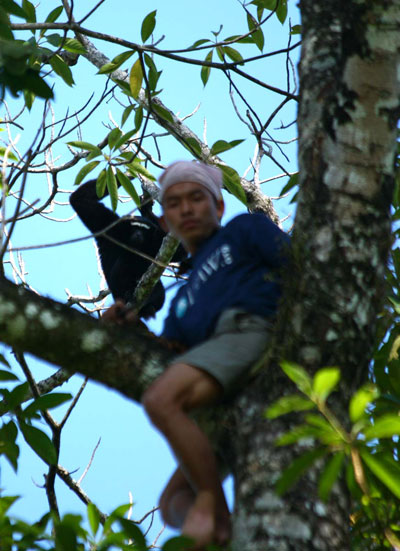
Gibbon released into new home. Photo by: Dipankar Bhagawati.
Two Hoolock gibbons have been successfully translocated from a fragmented forest to Mehao Wildlife Sanctuary in the beginning of a desperate bid to save 18 family groups of India’s last apes. Living near the village of Dello in northeastern India, the apes were straining to survive amid heavy deforestation and fragmentation.
“Dello is a small village which once hosted good tree cover and undoubtedly supported a healthy population of the eastern Hoolock gibbons. Of late, extensive felling of private forests has restricted the remnant population comprising 18 families in small clusters of trees surrounded by swathes of farmlands. The present situation offers no opportunity for the apes to forage optimally,” said Ipra Mekola,a state wildlife advisory member.
In good habitat gibbons almost never touch the ground, instead they forage high in the canopy moving gracefully and incredibly fast between trees. Gibbons have been dubbed the ‘lesser apes’, for while gibbons do not have a tail like other ape species—gorillas, chimps, and orangutans—they share some other characteristics with monkeys.
 Hoolock gibbon. Photo by: Sashanka. |
“Their physical attributes are not suited to walk and they can fall easy prey on ground, so it is very rare to see them descend from the canopy under natural circumstances,” explains Dr. Ian Robinson, International Fund for Animal Welfare (IFAW) Emergency Relief Director. IFAW and the Wildlife Trust of India (WTI) are aiding the Forest Department in the translocation.
Researchers knew the apes were trouble in Dello, when they had begun to come down to the ground seeking food.
“A month or so ago, a female and her young were killed in an attack by dogs,” Dr. Kuladeep Roy said, adding that another gibbon female has likely fallen as prey.
To capture the first two individuals—a male and juvenile—researchers confined the two to a ficus tree, and five team members climbed the tree while others waited on the ground. Once caught and sedated, the apes were safely released in Mehao Wildlife Sanctuary.
“The IFAW-WTI team will monitor the released gibbons for the next six months. This is our first ever attempt to translocate gibbons in India,” said Dr. NVK Ashraf, Chief Veterinarian with WTI.
There are two species of Hoolock gibbon in India: the eastern Hoolock gibbon (Hoolock leuconedys) and the western Hoolock gibbons (Hoolock hoolock). The eastern Hoolock gibbon is listed as Vulnerable by the IUCN Red List, while the western is listed as Endangered. The apes face a barrage of threats in India, including hunting for food and believed medicinal properties, deforestation, coal mining, oil extraction, and genetic isolation.

Dr. Abhijit Bhawal checking gibbon. Photo by: Dipankar Bhagawati.

Chasing the gibbon in the tree. Photo by: Dipankar Bhagawati.
Related articles

(09/01/2011) Given that we have very likely entered an age of mass extinction—and human population continues to rise (not unrelated)—researchers are scrambling to determine the best methods to save the world’s suffering species. In the midst of this debate, a new study in Science, which is bound to have detractors, has found that setting aside land for strict protection coupled with intensive farming is the best way to both preserve species and feed a growing human world. However, other researchers say the study is missing the point, both on global hunger and biodiversity.
Photos: 10 new frogs discovered in India’s great rainforest

(08/09/2011) Ten new species of frog have been discovered in India’s Western Ghats according to two new papers in Biosystematica. Although human populations have farmed in the Western Ghats for centuries, the new discoveries prove that the rainforest still holds many surprises. The Western Ghats lie along India’s west coast and have been dubbed one of the world’s biodiversity hotspots, but the rich wildlife is imperiled by rising human impacts.
Balancing agriculture and rainforest biodiversity in India’s Western Ghats

(08/08/2011) When one thinks of the world’s great rainforests the Amazon, Congo, and the tropical forests of Southeast Asia and Indonesia usually come to mind. Rarely does India—home to over a billion people—make an appearance. But along India’s west coast lies one of the world’s great tropical forests and biodiversity hotspots, the Western Ghats. However it’s not just the explosion of life one finds in the Western Ghats that make it notable, it’s also the forest’s long—and ongoing—relationship to humans, lots of humans. Unlike many of the world’s other great rainforests, the Western Ghats has long been a region of agriculture. This is one place in the world where elephants walk through tea fields and tigers migrate across betel nut plantations. While wildlife has survived alongside humans for centuries in the region, continuing development, population growth and intensification of agriculture are putting increased pressure on this always-precarious relationship. In a recent paper in Biological Conservation, four researchers examine how well agricultural landscapes support biodiversity conservation in one of India’s most species-rich landscapes.














